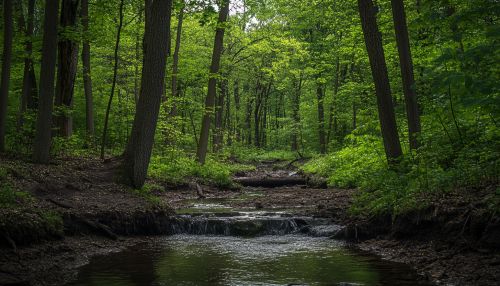Annie Dillard: Difference between revisions
No edit summary |
No edit summary |
||
| Line 11: | Line 11: | ||
Dillard's first major work, "Pilgrim at Tinker Creek," published in 1974, is a non-fiction narrative that explores the natural world around Tinker Creek in Virginia's Blue Ridge Mountains. The book won the 1975 [[Pulitzer Prize for General Non-Fiction]], establishing her as a significant voice in American literature. "Pilgrim at Tinker Creek" is often compared to Thoreau's "Walden" for its detailed observations of nature and philosophical musings. | Dillard's first major work, "Pilgrim at Tinker Creek," published in 1974, is a non-fiction narrative that explores the natural world around Tinker Creek in Virginia's Blue Ridge Mountains. The book won the 1975 [[Pulitzer Prize for General Non-Fiction]], establishing her as a significant voice in American literature. "Pilgrim at Tinker Creek" is often compared to Thoreau's "Walden" for its detailed observations of nature and philosophical musings. | ||
[[Image:Detail-98029.jpg|thumb|center|A serene forest landscape with a creek running through it.]] | [[Image:Detail-98029.jpg|thumb|center|A serene forest landscape with a creek running through it.|class=only_on_mobile]] | ||
[[Image:Detail-98030.jpg|thumb|center|A serene forest landscape with a creek running through it.|class=only_on_desktop]] | |||
=== Subsequent Publications === | === Subsequent Publications === | ||
Latest revision as of 09:50, 20 September 2024
Early Life and Education
Annie Dillard, born Meta Ann Doak on April 30, 1945, in Pittsburgh, Pennsylvania, is an American author known for her narrative prose in both fiction and non-fiction. She grew up in a household that encouraged intellectual curiosity and creativity. Her father, Frank Doak, was a business executive, and her mother, Pam Lambert Doak, was a homemaker with a keen interest in literature and the arts. Dillard attended the Ellis School in Pittsburgh, where she developed an early interest in writing and literature.
Dillard pursued higher education at Hollins University, earning a Bachelor of Arts in English in 1967 and a Master of Arts in 1968. During her time at Hollins, she studied under poet Richard Wilbur, who greatly influenced her literary style. Her master's thesis was a study of Henry David Thoreau, whose work would later resonate in her own writing.
Literary Career
Early Works
Dillard's first major work, "Pilgrim at Tinker Creek," published in 1974, is a non-fiction narrative that explores the natural world around Tinker Creek in Virginia's Blue Ridge Mountains. The book won the 1975 Pulitzer Prize for General Non-Fiction, establishing her as a significant voice in American literature. "Pilgrim at Tinker Creek" is often compared to Thoreau's "Walden" for its detailed observations of nature and philosophical musings.


Subsequent Publications
Following the success of "Pilgrim at Tinker Creek," Dillard published several other works that further solidified her reputation. "Holy the Firm" (1977) is a brief yet profound meditation on faith and the natural world, written during a three-day period of intense reflection. "Teaching a Stone to Talk" (1982) is a collection of essays that delve into themes of exploration, discovery, and the human relationship with nature.
In 1984, Dillard published her first novel, "The Living," which is set in the Pacific Northwest during the late 19th century. The novel is a historical epic that examines the lives of settlers and Native Americans, showcasing Dillard's ability to weave intricate narratives with rich historical detail.
Later Works
Dillard continued to write prolifically throughout the 1990s and 2000s. "The Writing Life" (1989) offers insights into her creative process and the challenges of being a writer. "For the Time Being" (1999) is a philosophical exploration of human existence, touching on themes of birth, death, and the passage of time. Her most recent work, "The Maytrees" (2007), is a novel that explores the complexities of love and relationships over several decades.
Themes and Style
Dillard's writing is characterized by its meticulous attention to detail and its deep philosophical inquiries. Her works often explore the intersection of nature, spirituality, and human existence. She employs a narrative style that blends lyrical prose with scientific observation, creating a unique voice that resonates with readers and critics alike.
One of the recurring themes in Dillard's work is the concept of seeing—both in a literal and metaphorical sense. In "Pilgrim at Tinker Creek," she writes extensively about the act of observing the natural world and the revelations that come from such close scrutiny. This theme is also evident in "Teaching a Stone to Talk," where she examines the ways in which humans interact with their environment.
Awards and Recognition
Throughout her career, Dillard has received numerous awards and honors for her contributions to literature. In addition to the Pulitzer Prize, she has been awarded the National Humanities Medal, the PEN/Faulkner Award, and the American Academy of Arts and Letters Award in Literature. Her work has been translated into multiple languages, and she is widely regarded as one of the most important American writers of the 20th and 21st centuries.
Personal Life
Dillard has been married three times. Her first marriage was to poet R.H.W. Dillard, whom she met at Hollins University. The couple divorced in 1975. She later married Gary Clevidence, with whom she had a daughter, Cody Rose. Her third marriage is to Robert D. Richardson, a biographer and historian.
Dillard has lived in various locations throughout her life, including the Pacific Northwest, New England, and the Mid-Atlantic. She currently resides in Key West, Florida, where she continues to write and engage with the literary community.
Legacy
Annie Dillard's work has had a profound impact on contemporary literature, particularly in the genres of nature writing and philosophical non-fiction. Her ability to blend scientific observation with poetic prose has inspired countless writers and readers. Dillard's exploration of the natural world and the human condition continues to resonate, making her a timeless figure in American letters.
See Also
- Henry David Thoreau
- Pulitzer Prize for General Non-Fiction
- Nature writing
- Hollins University
- Richard Wilbur
